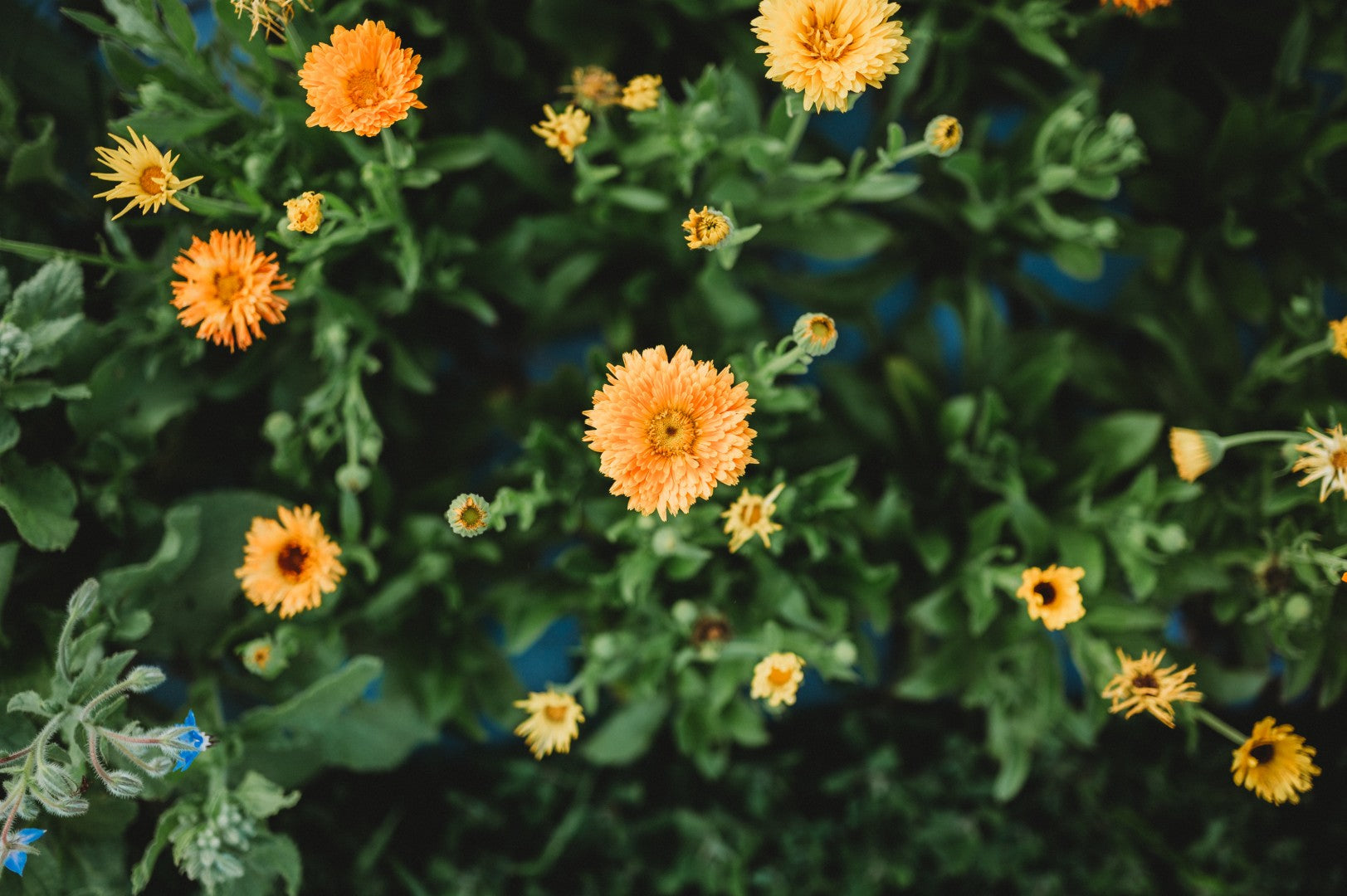Our little 1880s farm sits inside one of the most beautiful landscapes in Iowa—rolling hills, swaying prairies, and gentle rivers winding through wooded bluffs. It’s home to wild turkey, quail, pheasants, and—as you might guess from the title—a very healthy population of deer. On any given evening drive, it’s not unusual to see groups of thirty or more grazing along the roadside or slipping through the edge of the timber.
We love this place and the wildlife that shares it with us—but I’d be lying if I said I didn’t feel a pang of frustration when a deer helps itself to a freshly planted flowerbed. Coexisting with our curious (and often peckish) neighbors means finding ways to share the space without sacrificing every last bloom. Over the years, we’ve found a handful of flowers that reliably hold their ground, even in the face of heavy grazing pressure. Whether you're planting in pots, borders, or a cutting garden, these are the deer-resistant flowers that have worked best for us.

Black-Eyed Susan (Rudbeckia)
Black-eyed Susans are tough, cheerful perennials that thrive with very little fuss. Their coarse, hairy leaves make them unappealing to deer, and once they start blooming, they’ll carry on for weeks—often well into fall.
One standout variety we love is Gloriosa Daisy, a bold selection with oversized blooms and centers that range from bronze to deep burgundy. It’s just as tough and deer-resistant as its wild cousins but brings a little extra drama to the garden—and it holds up beautifully in a vase, too.

Bergamot (Bee balm)
Also known as bee balm, bergamot is a native member of the mint family with a strong, herbal fragrance that deer tend to avoid. The blooms are wild and frilly—ranging from lavender to pink depending on the variety—and they’re beloved by hummingbirds, bees, and butterflies alike.
We grow Monarda fistulosa, which also happens to grow wild in our river valley. Its ability to thrive untended in deer country is a testament to its toughness. Whether you’re planting in a pollinator garden or looking for something rugged and beautiful, this native monarda earns its place.

Coneflowers
We’re often asked, “Are coneflowers deer resistant?” The answer is yes—especially once they’re established. Young plants might get sampled occasionally, but mature coneflowers tend to be left alone. The leaves and stems are coarse and slightly bristly, which likely makes them unappetizing to deer.
We often see Purple Coneflower, or Echinacea purpurea growing wild in our area, right alongside monarda in the river valley. Its resilience in the landscape—and the fact that it can hold its own without fencing—is a big part of why we keep planting it. Plus, the blooms last for weeks and the seed heads feed finches all through winter.

Marigolds
If you know me, you know I have a soft spot for this fuss-free annual. I’ve been growing marigolds since I was barely tall enough to carry a watering can, and all these years later, they still find their way into nearly every corner of my garden. But my affection for marigolds isn’t just sentimental—it’s practical. They’re beautiful, drought-tolerant, and help keep pests at bay. And while I might love them dearly, the deer seem to find them entirely unremarkable—which, frankly, makes me love them even more.

Four O’Clocks
Named for their habit of opening in the late afternoon, Four O’Clocks bring a splash of tropical flair to the garden with lush foliage and trumpet-shaped blooms in shades of pink, yellow, magenta, and white. They thrive in heat, tolerate poor soil, and grow into bushy, vigorous plants that bloom steadily until frost.
Deer typically steer clear of them, possibly due to their strong fragrance and mild toxicity. That said, we’ve heard some gardeners in high-pressure areas report occasional browsing—so your mileage may vary. In our unfenced garden, they’ve held their own beautifully, and their late-day blooms never fail to bring a bit of magic to the landscape.

Pincushion Flower (Scabiosa)
Don’t let the delicate appearance fool you—pincushion flower is surprisingly tough and one of the few truly deer-resistant blooms in our cutting garden. The plants stay compact and tidy, with wiry stems that hold up clusters of soft, button-like flowers.
We grow the variety Imperial Mix, which produces a lovely blend of pink, lavender, and burgundy blooms. Deer walk right past it, but pollinators and garden guests take notice. The blooms are long-lasting in arrangements and add a touch of elegance without the worry of browsing.

Mexican Sunflower
If there’s one flower that truly earns its space in the garden, it’s Mexican sunflower. These tall, sun-loving plants burst with fiery orange blooms that pollinators adore—and the deer want nothing to do with. The coarse, fuzzy foliage is likely what keeps them away, but whatever the reason, we’re grateful.
Tithonia is one of our all-time favorites for sheer presence and performance. It grows fast, thrives in poor soil, and stands up to heat and drought like a champ. By late summer, the plants are often six feet tall and covered in blooms. It’s a magnet for monarchs, a powerhouse in the pollinator garden, and completely untouched in our deer-heavy slice of Iowa.

Zinnias
Zinnias are the workhorse of our summer garden: easy to grow, long-blooming, and—best of all—completely ignored by deer. We’ve never had a single plant browsed, even during peak deer season, which makes them one of our most dependable flowers year after year.
We grow both single-color types like Meteor, Green Envy, and Orange King for bold, solid accents, as well as classic mixes like California Giants, Dahlia Flowered, and Pumila (also known as Cut-and-Come-Again) for variety and volume. Whether planted in rows, borders, or pots, zinnias offer continuous color, endless bouquets, and peace of mind in deer country.
Bonus: Deer-Resistant Flowers for Containers
If you're gardening in a small space or just want to keep your favorite blooms close at hand, containers are the way to go. Fortunately, many deer-resistant flowers also happen to thrive in pots. We’ve had great success growing zinnias, marigolds, and pincushion flower in containers on porches, patios, and even tucked among vegetables. These varieties not only hold up to heat and neglect—they also hold their own against passing deer. Some other options include:
- Salvia
- Verbena
- Sweet Alyssum
- Snapdragons
- Calendula

Okay, One More: Deer-Resistant Fall Bloomers
Just because summer’s winding down doesn’t mean your garden has to. Several of our favorite deer-resistant flowers keep blooming well into fall, adding color when most plants start to fade. Black-eyed Susans and coneflowers are top performers, often holding their blooms into October. Zinnias keep going right up until the first hard frost. If you’ve ever wondered what fall flowers deer won’t eat—start with these. Here are some other solid choices.
- Chrysanthemums
- Ageratum
- Helenium (Sneezeweed)
- Russian Sage
- Goldenrod (Solidago)
Final Thoughts from a Deer-Dense Garden
Living and gardening in the company of deer has taught us a few things—chief among them, that a well-chosen flower can hold its own without fencing, sprays, or fist shaking. Every flower on this list has been trialed in our own unfenced garden, tucked into beds, borders, and containers surrounded by some of the hungriest deer Iowa has to offer.
If you're tired of losing your blooms to browsing, we hope this list gives you a place to start. Whether you're planting for pollinators, cut flowers, or pure summer color, these deer-resistant varieties have earned their place in our garden—and they just might earn a spot in yours.
Looking for seeds? Browse our full Deer Resistant Flowers collection to find all the varieties mentioned in this article... and more.






